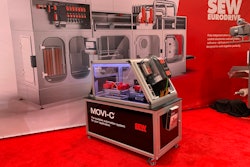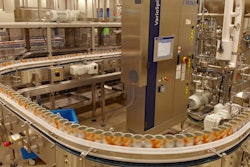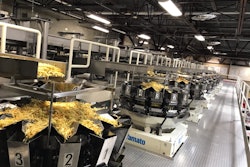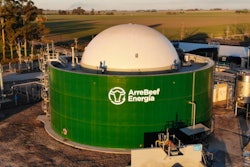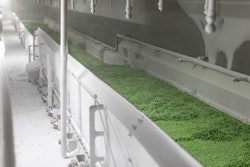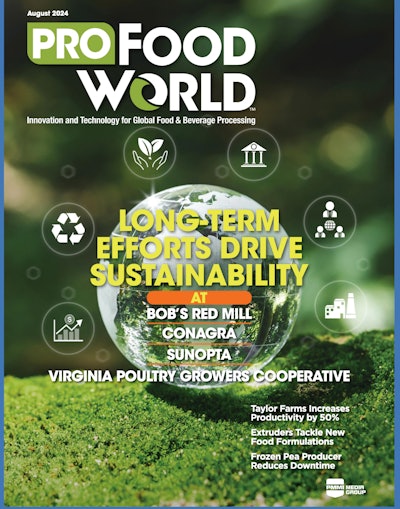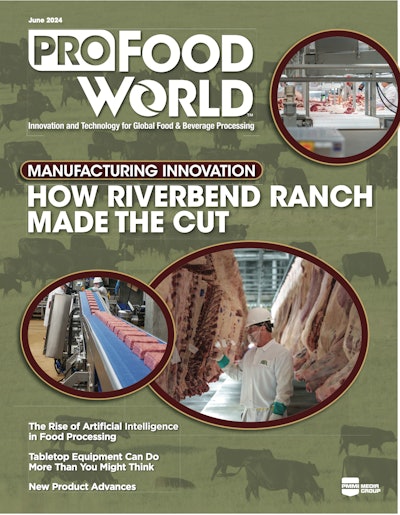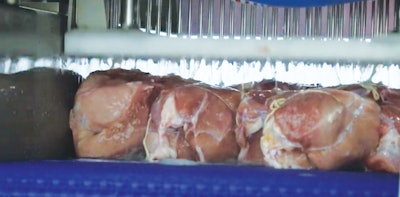
As a general rule, the food industry has lagged other industries in automating its processes. But there are times that call for automated systems—whether for improved reliability or repeatability, or simply because the job cannot get done with purely human methods.
Clarion Locker has built its business in Clarion, Iowa, on custom meat processing, performing live kills on site and processing cuts according to how families wanted to receive their meat. It was very specialized work, with everything done by hand. But much of the business model changed with the arrival of the COVID-19 pandemic, and now about 15% of its sales are in third-party butchering.
Without embracing more automated systems, there was just no way that Clarion could keep up with all the work at hand. The company had considering automating some its operations before, but the prospect was somewhat daunting, particularly with regard to cost. But then COVID-19 hit and changed the whole equation.
 Manie Nel and his wife Elmarie first opened in Clarion in 2009 as a custom processing facility. In 2020, they expanded Clarion Locker from 8,000 to 16,000 sq ft, tripling their processing throughput.Clarion Locker
Manie Nel and his wife Elmarie first opened in Clarion in 2009 as a custom processing facility. In 2020, they expanded Clarion Locker from 8,000 to 16,000 sq ft, tripling their processing throughput.Clarion Locker
Even since pandemic restrictions have lifted, the mad rush continues, Nel says. Some families, storing larger portions of animals in their freezers for the first time during lockdown, have gone back to traditional day-to-day purchases at their grocery stores, but others have continued buying from their local lockers. “Most processors out there are still a lot busier than they were before the COVID crisis,” Nel says.
Clarion Locker, like other small processors, found itself in need of help to process all the orders coming its way. One key automated system that the company embraced was an automated brine injector from BAK Food Equipment.
Improved throughput, quality, consistency
The key impetus behind the investment was the necessity to address the spike in products that needed to be cured and preserved. “I just couldn’t keep up,” Nel says. “I didn’t have enough hours in the day to do it the way I was doing it.”
Nel had been spending three or four hours injecting hams, dried beef, pork loins, etc. But when demand picked up during COVID, one employee was spending two whole days on this task. “Now, what I did in two days, I could do in less than an hour with this machine,” he says. “You mix the brine, you dump it in, and hit play. You just set the meat on the conveyor, and the machine does the rest.”
Clarion also saw a change in consistency with the automated process. “There are no more dead spots, where the cure doesn’t quite reach the meat. That usually occurs around the bone, and you’ll get a lot of that with hand injecting, so it’s inconsistent curing,” Nel says. “You also get a more regulated pump. If you set it at a 10 or 12% injection rate, it’s consistent through every product.”
BAK Food Equipment, which got its start with small meat processors, has seen the industry slower to innovate their processes with automation. “Although we see interest growing for this technology, we still find that many operators fear these automated solutions—that it will degrade their product or quality or flavor, or the level of comfort in using the automation. We also see concerns about automation increasing food prices or displacing the human element or workers,” says Tom Bako, director of business development for BAK Food Equipment. “These fears are simply untrue. Rather, automation can improve overall product quality, enhance flavor, allow workers to be reassigned to other, more interesting, or other needed areas of the plant, which could be less dangerous as well.”
Features of the brine injector
Nowicki MHM-68/204M Series meat brine injectors from BAK provide simple injection of brine into boned and boneless red meat, whole poultry and poultry parts, and fish and fish fillets. Constructed of stainless steel, the machines are designed to withstand hard washdown routines. The brine tank is also stainless steel, and the multistage brine filtration system is designed for easy cleaning.
MHM brine injectors allow both high- and low-percent injections with multifunctional one-, two-, three-, or four-needle injection heads. Injection heads strokes of 8 in. are standard, with 4- and 10-in. strokes also available. Two injection head speeds are standard, and injection heads can be swapped out quickly and easily.
 Constructed of stainless steel, MHM brine injectors are designed to withstand hard washdown routines.BAK Food Equipment
Constructed of stainless steel, MHM brine injectors are designed to withstand hard washdown routines.BAK Food Equipment
The injectors feature a simple and efficient power transmission system and a high-efficiency stainless-steel centrifugal pump for smooth brine pressure control to 3 bar. A helical pump for heavy brine is also available. The basic brine injectors include an easy-to-read and -operate control panel with an intuitive touchscreen, a plastic conveyer that’s easy to disassemble and clean, various conveyor speed controls, brine mixing and brine tank pump-out controls, and a closed brine circulation system.
Federal aid helps enable automation
Nel had considered automated injection previously, but it was COVID that gave him the push he needed—both in terms of demand and the funding available.
Another consequence of the pandemic was that many of these small meat processors received federal aid to help boost production. “That helped a lot with the growth of a lot of small lockers that had potential to grow but didn’t have the finances to do it,” Nel says. “That helped them automate too, and automation was needed due to the sudden spike in customer demand.”
Clarion has been using the automated brine injector—along with other bits of automation, such as a hamburger stuffer—for almost two years and has never looked back. “I think my [co-owner] wife would give me up before she gives up the injector because it’s really saved her a lot of time and headache too,” Nel quips. “The way we were doing things before, it was a specialized process that only certain individuals would be able to do. Even after training, it wasn’t guaranteed that the individual that was trained would do it correctly. With this injector, you could literally train anybody to do it; it’s not a specialized job, per se.”
Contrary to concerns about the potential of automation to displace workers, often, automation enables food processors to get jobs done that they couldn’t otherwise complete with the workers they have available to them. With manufacturers struggling to find qualified people, automation can also enable workers to become more versatile, Bako notes. “They can get trained on other processes, so it reduces a lot of stress amongst the workers. It gives them additional skills that they can transfer to other parts of the facilities,” he says. “Labor issues play a big role in food processors’ need for automation. Meat processors, in particular, are having to explore automation to keep up with market demand. With automation solutions, we can help these processors optimize their labor force and give their workers more interesting jobs, give them additional skills.”
